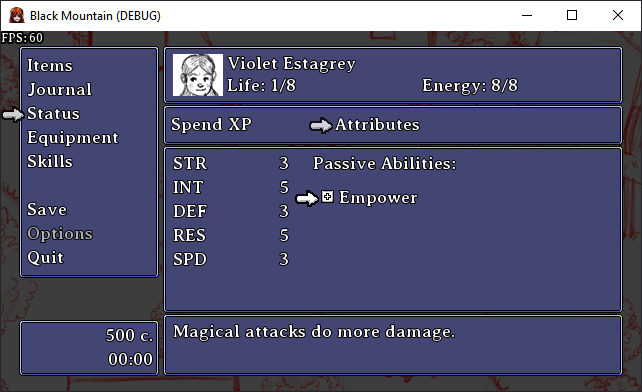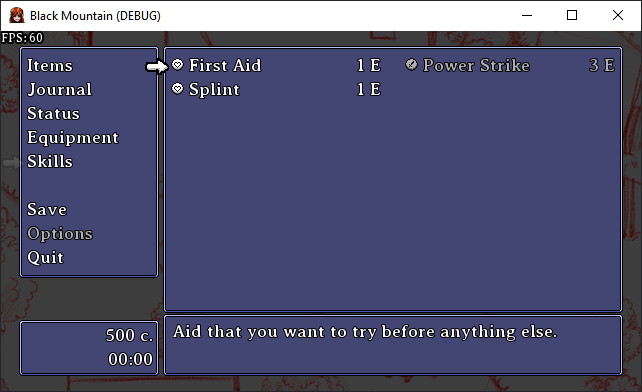- Rewrote how energy is used to power skills
- Made it possible to use skills outside of combat
Energy
I’m using the term “energy” in place of what you might more traditionally see as “MP” or similar in a jRPG. It’s a small thing, but magic is not as plentiful in the world that Black Mountain is set as you generally see in the most RPGs; most people in the world (including characters in your party) do not have a great deal of experience with magic, and are much more likely to encounter it in the form of lightly-enchanted items than to be wizards themselves. I mentioned last week that the main character is a healer – I mean this in the traditional sense, not a magical one. She doesn’t have any magical healing ability, and such a thing is quite rare. (I actually hope to explore that, and the tension between traditional healing and magical healing (and the practitioners of the two) in more detail some day in Geas!) Anyway, point is: “energy” is a more general idea than a “mana” pool or something similar, it just represents the character expending internal reserves before they’re exhausted, meaning it will be used for skills and powers that are not actually magical in addition to “casting spells”.
Along with that, like any good epic fantasy hero, the characters have the option to overdraw themselves. You can continue to use skills even if your energy is depleted; you will start using your own health, instead. This could be dangerous but it might be a worthwhile tradeoff in the moment.
Right now, of course, there’s the issue that using a simple First Aid skill causes less damage than it heals. I’ll have to fix that, and I’m not exactly sure how yet; either I’ll fiddle with the numbers and ratios so that isn’t possible, or some skills will not be usable by burning life points. We’ll see.
Interfaces
I’ve also finished up the interface work I started last time.

“Attributes” shows the characters stats and a list of any passive skills they have unlocked. Because of the complex and time-consuming nature of magic, a student of magic like Violet will not generally gain access to new and more powerful spells simply by levelling up – the spells will be part of equipment, usually as gems/runestones/whatever that socket into a weapon, which anyone can use. Instead, someone with actual knowledge of magic will be better at using those spells, casting them better and more safely than others.

“Skills” is now a list of all skills the character has available. They’re greyed out if they’re combat-only skills, and they’re red (not pictured) if using them would damage the character.
There were also changes within combat (including the ability to use ANY skill even if doing so will outright KO the character, just in case an old man ever needs to cast Meteo…), and I realized that I haven’t really talked much about combat yet. It’s actually in there, already; I built most of it before I started posting about the game. It’s got some issues, though, and some things to work out, so I’ll probably just try to dedicate a post to it in the future.
Moving On
With this sorted out, and a few last ideas that I’ve moved to the “maybe for a future game” category, I’ve actually sketched out the alpha/playtest version of all the mechanical building blocks of the game. I’ve got lots of bugs and other things to address, and I’ll definitely need to build some more pieces as I figure out what I need, but I’m going to basically be shifting gears going forward to focus on building out the “draft” version of the game.
In my head (and in my notes) I have a handful of milestones that I’ve mapped out. Hitting this point is sort of a mini-milestone, I suppose, but the real first milestone is what I’m referring to as a “draft” (or version 0.1). It’s going to have placeholder art, questionable UI, mediocre writing, and lots of bugs, but it will be the main story beats of the whole game, beginning to end. The point of the draft is to get it to a place that someone else can actually play the game all the way through and actually understand it as a game (and hopefully even enjoy it at least a little) with a minimal amount of me waving my hands and explaining things that there yet. Hopefully I’ll be able to use this version to bring some other people on board to help me, especially with art. We’ll see.
For what it’s worth, this process might be a horrible idea, and I don’t necessarily recommend anyone else follow it! I also know it’s pretty unusual for how a game is normally built. A much more usual flow would be to build a very short slice of the game, polished to somewhere close to the “real” version of it, and use that to get a publisher on board or something like that. In this case, I have a reasonably clear(ish) idea of what I want from the game, and it’s a passion project. I’m not really concerned with finding a publisher ASAP, but I do want to work with other people on it. It felt like the right course forward, then, was to focus first on getting the basic framework nailed down and the whole game sketched out so my vision is (hopefully) clear. It’ll be interesting to find out if it works out as well as I want it to.